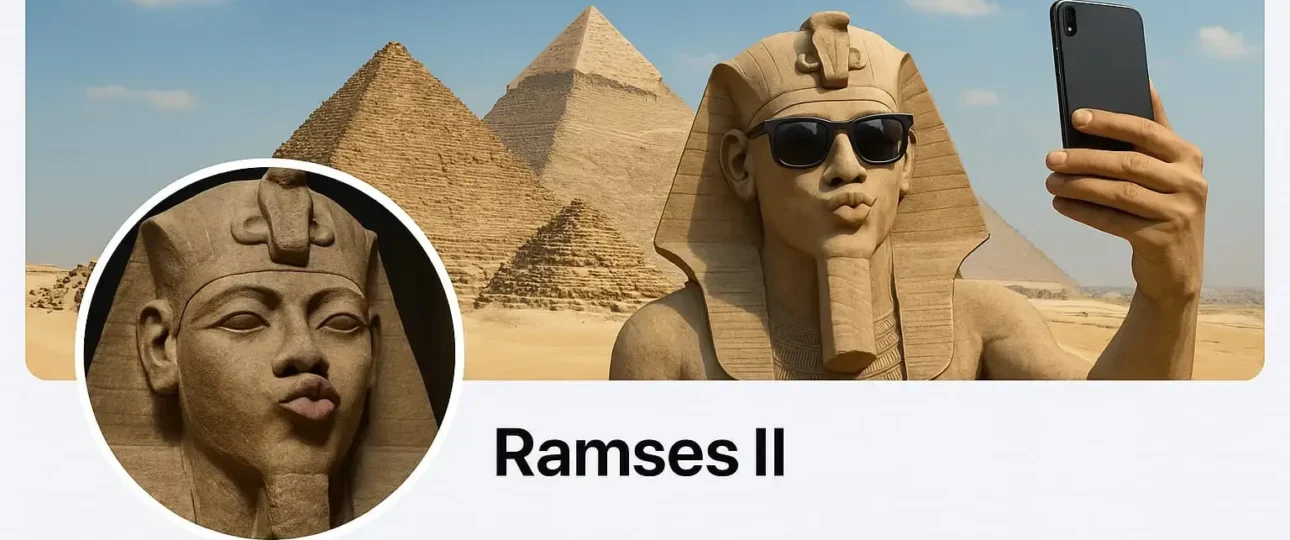What if Ancient Egypt had Facebook? Stone age posts
Long before hashtags and algorithms, ancient Egypt’s temples functioned as the ultimate social media platforms. The Ancient Egypt Facebook Page Concept thrived through colossal statues, hieroglyphic “posts,” and divine humblebrags carved in stone. Pharaohs like Ramses II and Hatshepsut curated their legacies with the precision of modern influencers, using temples to broadcast their divinity, victories, and alliances. These structures weren’t just sacred spaces—they were meticulously crafted profiles designed to awe followers (and enemies) for eternity. From towering profile pics at Abu Simbel to “timeline” murals at Karnak Temple, every wall told a story. Imagine status updates etched in granite: military conquests, godly collabs, and even geopolitical marriages. This article explores how pharaohs mastered social media—3,000 years before Zuckerberg—by blending myth, propaganda, and stone-cold charisma.
Profile Pics: Divine Selfies Carved in Stone
Forget duck-face selfies—pharaohs immortalized their image with 60-foot statues. Flanking temple entrances, these colossal figures served as their eternal profile pictures, airbrushed to perfection. At Abu Simbel, Ramses II’s four seated statues weren’t just art; they were flexes in sandstone, declaring, “I’m literally built different.” Carved to withstand millennia, these icons blended godhood and royalty, ensuring every visitor knew who ruled.
Hatshepsut, Egypt’s trailblazing female pharaoh, took creative liberties. Her Deir el-Bahari temple depicted her with a male physique and ceremonial beard—a Bronze Age Photoshop job to legitimize her reign.
Cover Photos: Battle Murals and Humblebrags
Scroll past the profile pic, and temple pylons unveiled epic cover photos. Ramses III’s Medinet Habu featured a gory “Battle of the Delta” mural—ancient clickbait showing him decimating Sea Peoples. Caption: “Just saved Egypt. #BlessedByAmun.” For pious kings, the vibe shifted. Hatshepsut’s cover photo showed her offering wine to Amun, captioning it: “Big thanks to my divine mentor! 🙏 #CareerGoals.”
These visuals weren’t random. They strategically mixed piety and power, like a CEO’s LinkedIn banner. The message? “I’m a warrior and a saint.” Tourists today still gawk at these carvings—proof that good branding never dies.
The ‘About’ Section: God-King Bios
No profile is complete without a bio, and pharaohs wrote theirs in hieroglyphs. Titles like “Son of Ra” or “Lord of Two Lands” filled temple walls—the Bronze Age version of “Visionary Leader 🌍✨.” Thutmose III’s Karnak Temple bio listed 350 conquered cities. Relationship status? “Married to Egypt.”
Birth myths added celestial clout. Hatshepsut’s temple claimed the god Amun fathered her, with murals showing him handing her the crown. Move over, nepo babies—this was divine nepotism. These bios blended myth and résumé, ensuring their legacy trended for centuries.
Timeline Posts: Hieroglyphic Check-Ins
Inner temple walls acted as pharaohs’ timelines. Thutmose III’s annals at Karnak read like a military travel blog: “Conquered Megiddo—views were fire. #NoRetreat.” Amenhotep III’s Luxor feed documented his Sed Festival: “Throwing a rager for 10k guests. DJ Khnum on the decks! 🎉”
Unlike fleeting Instagram stories, these posts were carved for eternity. Each victory, offering, or alliance was set in stone, blending history and propaganda. Modern influencers could never.
Friends & Followers: Tagging Deities
Pharaohs’ “friends lists” included gods like Amun and Osiris, tagged in every post for clout. When Amenhotep III married a Mitanni princess, he updated his status: “In a geopolitical situationship 💍.” Followers? Priests (admins), citizens (liking posts with bread offerings), and graffiti artists scribbling “Khaemwaset was here”—the original comment section.
Drama unfolded too. Thutmose III erased Hatshepsut’s statues posthumously—the ultimate block. Akhenaten’s monotheistic posts got him shadowbanned, his temples scrubbed like a deactivated account.
Legacy: Eternal Engagement Metrics
While TikTok fame fades in hours, pharaohs played the long game. Karnak Temple’s 4,000-year engagement rate still crushes Instagram. Hatshepsut’s erased legacy? A cautionary tale: “Don’t let jealous nephews admin your page.”
The Great Pyramid remains the OG viral post, amassing 4.5 billion impressions. Meanwhile, MySpace? Dust. Pharaohs knew stone > servers. Next time you post a selfie, remember: Ramses II’s profile pic has been “liked” for 3,200 years.

